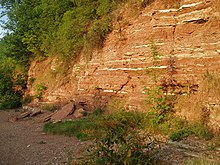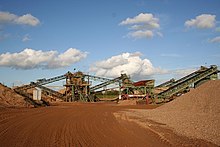User:Jokulhlaup/draftarticle25
| This is not a Wikipedia article: It is an individual user's work-in-progress page, and may be incomplete and/or unreliable. For guidance on developing this draft, see Wikipedia:So you made a userspace draft. Find sources: Google (books · news · scholar · free images · WP refs) · FENS · JSTOR · TWL |
Geology
Underlying the upper reaches of the Trent, are formations of

Downstream of Armitage the solid geology is primarily Mercia Mudstones, the course of the river following the arc of these mudstones as they pass through the Midlands all the way to the Humber. The mudstones are not exposed by the bed of the river, as there is a layer of gravels and then alluvium above the bedrock. In places, however the mudstones do form river cliffs, most notably at Gunthorpe and Stoke Lock near Radcliffe on Trent, the village being named after the distinctive red coloured strata.[4][2]
The low range of hills, which have been formed into a steep set of cliffs overlooking the Trent between Scunthorpe and Alkborough are also made up of mudstones, but are of the younger Rhaetic Penarth Group.[2][1]
In the wider catchment the geology is more varied, ranging from the Precambrian rocks of the Charnwood Forest, through to the Jurassic limestone that forms the Lincolnshire Edge and the eastern watershed of the Trent. The most important in terms of the river are the extensive sandstone and limestone aquifers that underlie many of the tributary catchments. These include the Sherwood sandstones that occur beneath much of eastern Nottinghamshire, the Permian Lower Magnesian limestone and the carboniferous limestone in Derbyshire. Not only do these provide baseflows to the major tributaries, the groundwater is an important source for public water supply.[2]
| Gravel Terraces of the River Trent[5] | ||
|---|---|---|
| Name | Age thousand yrs BP |
Stage |
Eagle Moor
|
> 400 | Anglian
|
| Etwall / Whisby Farm |
297 | Early Wolstonian
|
| Egginton / Balderton |
195 | Late Wolstonian
|
| Beeston / Scarle |
80 | Devensian
|
| Holme Pierrepont | 26 | Devensian
|
| Hemington | 10 | Flandrian
|
Sand, gravels and alluvium deposits that overlie the mudstone bedrock occur almost along the entire length of the river, and are an important feature of the middle and lower reaches, with the alluvial river silt producing fertile soils that are used for intensive agriculture in the Trent valley. Beneath the alluvium are widespread deposits of sand and gravel, which also occur as gravel terraces considerably above the height of the current river level. There is thought to be a complex succession of at least six separate gravel terrace systems along the river, deposited when a much larger Trent flowed through the existing valley, and along its ancestral routes through the water gaps at Lincoln and Ancaster.[6][7]
This ‘staircase’ of flat topped terraces was created as a result of successive periods of deposition and subsequent down cutting by the river, a product of the meltwater and glacially eroded material produced from ice sheets at the end of glacial periods through the Pleistocene epoch between 450,000 and 12,000 years BP. Contained within these terraces is evidence of the

The lower sequences of these terraces have been widely quarried for sand and gravel, and the extraction of these minerals continues to be an important industry in the Trent Valley, with some three million tonnes of aggregates being produced each year.[5] Once worked out, the remaining gravel pits which are usually flooded by the relatively high water table have been reused for a wide variety of purposes. These include recreational water activities, and once rehabilitated, as nature reserves and wetlands.[9]
During the end of the last
Reflists

- ^ a b British Geological Survey. "Geology of Britain map". British Geological Survey. Retrieved 25 August 2013. - Zoomable map - click to obtain the bedrock and superficial geologies.
- ^ a b c d "Geological Evolution of Central England with reference to the Trent Basin and its Landscapes". nora.nerc.ac.uk. Retrieved 19 June 2013.
- ^ "The BGS Lexicon of Named Rock Units — Gunthorpe member". bgs.ac.uk. Retrieved 11 July 2013.
- ISBN 9780191578472.
- ^ a b "The Lower and Middle Palaeolithic Occupation of the Middle and Lower Trent Catchment and Adjacent Areas, as Recorded in the River Gravels used as Aggregate Resources" (PDF). tvg.bham.ac.uk. 2004. pp. 16–20. Retrieved 10 June 2013.
- ^ a b "River Trent: Archaeology and Landscape of the Ice Age" (PDF). Archaeology Data Service. p. 14-15,27. Retrieved 19 June 2013.
- ^ "The BGS Lexicon of Named Rock Units - Trent Valley Formation". bgs.ac.uk. Retrieved 11 July 2013.
- ^ Lister, Adrian; Brandon, Allan (1991). "A pre-Ipswichian cold stage mammalian fauna from the Balderton Sand and Gravel, Lincolnshire". Journal of Quaternary Science. wiley.com. Retrieved 11 July 2013.
- ^ "Trent Vale Landscape Character" (PDF). trentvale.co.uk. p. 11. Retrieved 10 September 2013.
- ^ "The Humberhead Levels Natural Area" (PDF). naturalengland.org.uk. Retrieved 19 June 2013.

